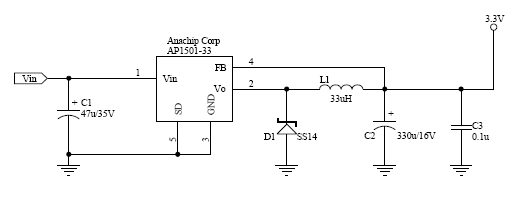Power, Reset, and Mode Selection Lines
The EM1206 should be powered from a stabilized DC power supply with nominal output voltage of 3.3V (±5% tolerance). The current consumption of the EM1206 is approximately 230mA (PLL on, 100BaseT mode). Providing an adequate power supply is very important — a poorly built circuit may affect EM1206 operation. We recommend that you use a switching power supply. One (but not the only) example of such a circuit is shown below.
A proper external reset is not required. The EM1206 has a reliable power-on reset circuit with brown-out detection. Optionally, you can connect a reset button or some other reset-generating circuit to the RST pin of the EM1206. This will allow you to generate "external" resets. The RST line has active HIGH polarity. If you are not using the RST pin, you can leave it unconnected.
The main clock frequency of the EM1206 is generated by an 11.0592MHz crystal connected to the onboard PLL circuit. When the PLL is off, the EM1206 is clocked at 11.0592MHz. When the PLL is on, the main clock is eight times higher at 88.4736MHz. Naturally, with PLL on the EM1206 works eight times faster and consumes more current (230mA with PLL on against 110mA with PLL off). The main clock frequency also affects the baudrates of serial ports when in the UART mode, as well as the frequency produced by the square wave generator.
The PLL cannot be switched off and on while the EM1206 is running. This is because when PLL mode changes, its output needs some time to stabilize. For this reason, the PLL mode of the EM1206 can only be changed on reset. A special internal delay circuit will hold the EM1206 in reset while PLL frequency stabilizes.
Unlike the EM1000, the EM1206 does not have a hardware pin to control the state of the PLL. On power up, the PLL is always enabled. Your Tibbo BASIC/C application can change the PLL mode programmatically. The application can check the current PLL mode through the sys. object. If the PLL mode needs to be changed, the application can set new mode and then perform an internal reset (again, through the sys. object). The internal reset is identical to the power-on or external reset with one difference: the PLL mode will not default to "PLL on" but instead will be set as requested by the application prior to the reset.
The function of the MD line is described in Setup (MD) Button (Line).
Power Supply Circuit
Many power supply circuits will work well. The one below is used by Tibbo. The circuit can handle input voltages in the 9V~24V range.

Notes:
- U1 (AP1501-33) is a popular power IC manufactured by Anachip (now Diodes Inc. — www.diodes.com).
- C1 and C2 capacitors: Do not use SMD capacitors — use regular through-hole aluminum capacitors. This really helps reduce noise produced by the power supply.
- This is an analog circuit, so layout matters. Apply reasonable "good layout" effort.
 Ideally, you should use an oscilloscope to see what sort of "square wave" the power supply generates, both at low and high input voltages, as well as light and heavy loads. There are no recipes here — just try and see what works for your circuit.
Ideally, you should use an oscilloscope to see what sort of "square wave" the power supply generates, both at low and high input voltages, as well as light and heavy loads. There are no recipes here — just try and see what works for your circuit.
